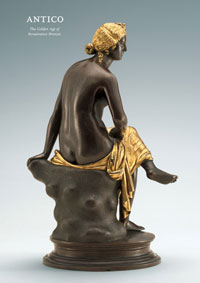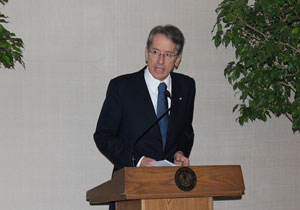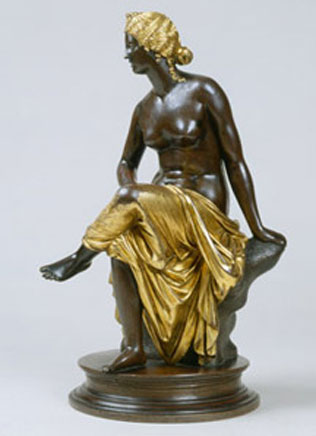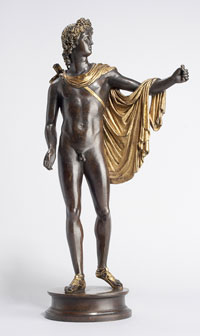
| HOME |
| INDEX ARTICLES |
| CONTACT US |
|
Antico's Rare Renaissance Sculpture at the National Gallery of Art, Washington, in First Show of His Work in United States
![]()
November 6, 2011 - Washington, DC — Pier Jacopo Alari Bonacolsi, known as Antico (c. 1455–1528), transformed the art of bronze sculpture. His contributions are celebrated inAntico: The Golden Age of Renaissance Bronzes, the first  monographic exhibition in the United States devoted to the Italian sculptor and goldsmith. On view at the National Gallery of Art, Washington, from November 6, 2011, through April 8, 2012, the exhibition includes some 40 rare works—medals, reliefs, busts, and Antico's renowned statuettes—more than three-quarters of the sculptor's known works.
monographic exhibition in the United States devoted to the Italian sculptor and goldsmith. On view at the National Gallery of Art, Washington, from November 6, 2011, through April 8, 2012, the exhibition includes some 40 rare works—medals, reliefs, busts, and Antico's renowned statuettes—more than three-quarters of the sculptor's known works.
In 2008–2009, the first monographic exhibition on Antico was presented at the restored apartments of Isabella d'Este in the Ducal Palace in Mantua, Italy.
"The late Robert H. Smith, former president of the Gallery, was one of the keenest admirers and collectors of Antico's work, and his vision and generosity have made the Gallery a leader in the study of Renaissance bronzes," said Earl A. Powell III, director, National Gallery of Art. "The exhibition and accompanying catalogue are dedicated to Bob's memory and serve as a tribute to his leadership as a collector and philanthropist."
Exhibition Organization and Support
Antico: The Golden Age of Renaissance Bronzes was organized by the National Gallery of Art, Washington, in association with The Frick Collection, New York, where it will be on vi ew from May 1 through July 29, 2012.
ew from May 1 through July 29, 2012.
The exhibition is made possible by the generous support of Robert H. and Clarice Smith.
It is supported by an indemnity from the Federal Council on the Arts and the Humanities.
The exhibition is part of ITALY@150, a series of activities in Washington, DC, and throughout the United States that celebrates the 150th anniversary of the unification of Italy and the long-lasting friendship between the two countries.
The Exhibition
The exhibition presents 37 masterpieces by Antico, grouped thematically and installed with related works by fellow Gonzaga court artist Andrea Mantegna (c. 1431–1506), Giovanni Bellini (c. 1430/1435–1516), and others.
 Antico's earliest known work in the exhibition is an elegant portrait medal representing his patron, Gianfrancesco Gonzaga (c. 1479–1482), wearing contemporary clothing. In a later medal, he is portrayed as an ancient figure, wearing antique-style Roman drapery.
Antico's earliest known work in the exhibition is an elegant portrait medal representing his patron, Gianfrancesco Gonzaga (c. 1479–1482), wearing contemporary clothing. In a later medal, he is portrayed as an ancient figure, wearing antique-style Roman drapery.
The exhibition includes Antico's finest statuettes, such as the Seated Nymph(1503, Robert H. and Clarice Smith), a beautiful example of the rich interplay of gilded, silvered, and patinated surfaces. Highlighting the refinement Antico achieved in the modeling of the hair and drapery, this work is identified through surviving letters as a statuette made for the private study of the famous Marchesa of Mantua, Isabella d'Este. The Seated Nymph is reunited, for the first time, with four other bronze statuettes from the Kunsthistorisches Museum in Vienna that were also most likely made for Isabella's study:Hercules and Antaeus (1519), Pan (probably after 1519), Atropos (probably after 1519), and Hercules (probably after 1519).
Two sculptures from antiquity that served as models for Antico are on view, offering insights into how he interpreted the classical precedents that are at the core of his artistic output. An example of this relationship in the exhibition is the loan from the Hispanic Society of America, New York, of a marble Roman portrait bust of a young man (c. AD 140–150), which is the source for Antico'sYoung Man (c. 1520, The J. Paul Getty Museum, Los Angeles). Antico's bronze inventions in turn promoted ancient Roman statuary, such as the Apollo Belvedere, excavated in Rome in 1489, that became widely appreciated through Antico's multiples of small bronzes.
As part of the exhibition project, Gallery conservators have undertaken a technical study of Antico's innovative casting and finishing techniques that shed new light on his workshop practices. Several casts of a single model—including two of Hercules, Apollo Belvedere, and Atropos—are on view to illustrate the issues that arise in serializing bronzes. Text panels describe Antico's complex casting technique for statuettes and his methods of patination, gilding, and silvering.
The exhibition would not be possible without the cooperation of the Kunsthistorisches Museum, Vienna, the greatest repository of sculpture by Antico, which lent ten works of art to the exhibition.
Pier Jacopo Alari Bonacolsi, known as Antico (c. 1455–1528)
Probably born in Mantua, Antico is first documented in 1487. He is known to have been married with children by 1496. Antico spent his entire career in the service of the Gonzaga family. His first patron was Gianfrancesco Gonzaga di Ròdigo, lord of Bozzolo (1446–1496), followed by bishop-elect Ludovico Gonzaga (1460–1511), Gianfrancesco's younger brother. By 1501, Antico was working and living at the court of Gazzuolo, the residence of Gianfrancesco's widow, Antonia del Balzo (c. 1460–1538), and bishop-elect Ludovico. After Ludovico's death, the Marchesa Isabella d'Este (1474-1539) in Mantua became Antico's principal patron. The artist is recorded as restoring antique marble statues in Rome, but his greatest works were commissioned by the Gonzaga family over three generations.
Exhibition Curator and Catalogue
The exhibition is organized by Eleonora Luciano, associate curator of sculpture, National Gallery of Art, in collaboration with Denise Allen, curator, The Frick Collection, New York, and Claudia Kryza-Gersch, curator of Italian sculpture, Kunsthistorisches Museum, Vienna.
The exhibition catalogue, copublished by the National Gallery of Art and Paul Holberton publishing, is the only available English-language monograph on Antico. The catalogue features a series of essays providing an overview of the artist's career—placing Antico's life, work, and technique in a contextual framework critical to understanding his sculptures—and includes the results of technical studies undertaken by object conservators at the National Gallery of Art and The Metropolitan Museum of Art. The catalogue also addresses little-discussed topics, from the chronology of his works to aspects of his technique and his relationship with the Court of Mantua.
In addition to essays by Luciano, Allen, and Kryza-Gersch, the catalogue includes contributions by Stephen J. Campbell, professor and chair of the department of art history, Johns Hopkins University; Davide Gasparotto, curator, Galleria Nazionale di Parma; Dylan Smith, Robert H. Smith Research Conservator, National Gallery of Art; Richard Stone, senior museum conservator emeritus, Sherman Fairchild Center for Objects Conservation, The Metropolitan Museum of Art; and Shelley Sturman, senior conservator and head of the department of object conservation, National Gallery of Art.
The 224-page catalogue includes 163 illustrations and is available in hardcover for purchase in the Gallery Shops. To order, please visit our Web site atwww.nga.gov/shop; call (800) 697-9350 or (202) 842-6002; fax (202) 789-3047; or e-mail mailorder@nga.gov.
SOURCE: National Gallery of Art
Pictures, NGA and Italian Embassy
|CiaoAmerica.net|